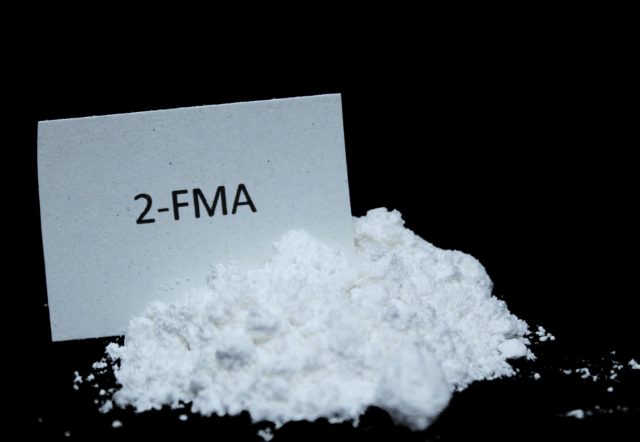If you’re researching 2-FMA, you’re likely sifting through conflicting reports of its benefits and risks. This post aims to provide a clear, objective, and harm-reduction focused perspective on this substance, separating the functional fantasy from the pharmacological reality.
Disclaimer: This post is for informational purposes only and does not constitute medical or legal advice. I do not endorse or encourage the use of illegal or untested substances. The safest choice is always to avoid use altogether.
What is 2-FMA?
2-FMA is a synthetic stimulant of the substituted amphetamine class. As the name suggests, it is a structural analogue of methamphetamine, with a fluorine atom attached to the second carbon of its phenyl ring. This small chemical tweak significantly alters its effects profile compared to its infamous cousin.
It emerged as a „legal high“ or „research chemical“ intended to circumvent drug laws banning more well-known substances. However, it is now explicitly illegal in many countries, including under analogue acts in the US and blanket bans in the EU.
The Reported Effects: The „Productivity“ Promise
User reports from online forums and communities paint a consistent picture: 2-FMA is prized for its lack of euphoria compared to other stimulants. Instead, users seek it out for:
- Intense Focus: The ability to hyper-focus on tasks for extended periods.
- Increased Alertness & Wakefulness: Combating fatigue and promoting sustained mental energy.
- Cognitive Enhancement: Reported improvements in motivation, concentration, and productivity.
- Suppressed Appetite: A common side effect of most stimulants.
- Minimal „High“: This is its key selling point for functional users; it provides energy without the intense euphoria that can be distracting or lead to recreational abuse.
The duration is often reported to be long, sometimes lasting 6-10 hours, which contributes to its appeal for all-day work or study sessions.
The Unavoidable Risks: Beyond the Productivity Myth
The functional label is dangerously misleading. Using 2-FMA is not a safe biohack; it is an uncontrolled experiment with your health. The risks are profound:
- The Ultimate Unknown: 2-FMA is a research chemical with zero clinical studies. Its long-term effects on the human brain, cardiovascular system, and other organs are completely unknown. Chronic use could lead to unforeseen neurological, psychiatric, or physical damage that may not become apparent for years.
- Cardiovascular Damage: Even without a strong „high,“ 2-FMA is still a potent stimulant. It significantly increases heart rate and blood pressure. This puts sustained strain on the cardiovascular system, elevating the risk of hypertension, arrhythmia (irregular heartbeat), heart attack, and stroke—especially with repeated use.
- Neurotoxicity Concerns: Based on its similarity to other fluorinated amphetamines (like 2-FA, which has shown neurotoxic potential in animal studies), there is a strong scientific rationale to suspect that 2-FMA may be neurotoxic. It could potentially cause damage to dopamine and serotonin neurons, leading to long-term issues like anhedonia (inability to feel pleasure), depression, anxiety, and cognitive deficits.
- The Psychological Toll: The „functional“ effects can easily blur into negative states:
- Increased Anxiety and Irritability: Especially as the drug wears off.
- Sleep Disruption: Insomnia is almost guaranteed if taken too late in the day, disrupting natural sleep cycles and next-day cognitive function.
- Dependence and Addiction: While less recreational, the motivation and energy it provides can be powerfully reinforcing. Psychological dependence can develop, where users feel they cannot be productive or focused without it. The comedown can also lead to cravings and a cycle of redosing.
- Legal Ramifications: 2-FMA is a controlled substance in many parts of the world. Possession or distribution can result in severe legal consequences, including felony charges, fines, and imprisonment, which would derail any academic or career goals it was meant to enhance.
Harm Reduction: If You Choose to Proceed (Despite The Risks)
The only safe use is no use. However, if an informed adult makes the choice to proceed, ignoring harm reduction is irresponsible. Your safety depends on it.
- Test Your Substance: This is non-negotiable. You cannot trust a dealer’s word. Use a reagent testing kit (e.g., Marquis, Simon’s, Robadope) to verify the substance and screen for dangerous adulterants. Always use a fentanyl test strip.
- Dose with Precision: Use a milligram scale. Never estimate. Start with a minuscule „allergy test“ dose (e.g., 1-2mg) to check for adverse reactions before considering a functional dose.
- Avoid Redosing: Its long duration means redosing will almost certainly lead to insomnia and a more severe comedown. Establish a strict, one-dose rule and never use on consecutive days.
- Hydrate and Nourish: Set reminders to drink water and eat nutritious food, as the drug will suppress your appetite and thirst cues.
- Never Use Alone: Have a trusted friend aware of your use who can check in on you and be ready to call for help in an emergency.
- Plan for the Comedown: The drop-off can involve fatigue, brain fog, irritability, and low mood. Have a plan for rest, healthy food, and hydration. Avoid using other substances to cope.
- Know Overdose Signs: Extreme agitation, chest pain, severe headache, confusion, hyperthermia (overheating), and tachycardia. If you or someone else experiences these, call emergency services immediately. Be honest with medical personnel.
The Final Word
2-FMA is not a smart drug; it is a dangerous gamble. The promise of enhanced productivity is a facade that hides potential for significant physical harm, neurological damage, and psychological dependence.
The pursuit of academic or professional success should not come at the cost of your long-term health. Sustainable productivity is built on foundations of proper sleep, nutrition, exercise, and proven study techniques—not on untested and illegal chemicals.



The clarity here is outstanding.